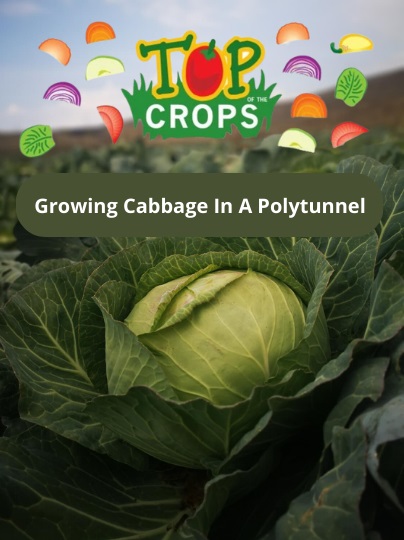Cabbages are a crop that we can grow in a polytunnel all year round. There are cabbages suited to every season. The key to successfully growing cabbages throughout the year is choosing the right varieties for each time of year and for where you live.
There are four broad categories of cabbage, based on when they are harvested. These are: summer cabbages, autumn cabbages, winter cabbages and spring cabbages. The names refer to the period during which the specific cabbage varieties are harvested.
Cabbage is the name given to a number of cultivars of Brassica oleracea. These are descendants of wild cabbage, Brassica oleracea var. oleracea, and are closely related to other brassicas like broccoli, cauliflower, Brussels sprouts etc...
Like all brassicas, cabbage requires a sunny spot with fertile soil and it is a hungry crop when it comes to its nitrogen requirements.
Though cabbages can cope with partial shade, they will usually do best in full sun. And they should be placed in a moist yet free-draining soil that is rich in organic matter, with pH that is not too acidic.
You can grow them in a polytunnel, or outside in your vegetable garden. Some cabbages are also highly ornamental and will not look out of place amid your flower beds in edible and ornamental planting schemes. While cabbages to best in the ground they can also potentially be grown in containers.
| Jan | Feb | Mar | Apr | May | Jun | Jul | Aug | Sep | Oct | Nov | Dec | |
| Sow |  |
 |
 |
 |
 |
 |
 |
 |
||||
| Plant |  |
 |
 |
 |
 |
 |
 |
 |
||||
| Harvest |  |
 |
 |
 |
 |
 |
 |
 |
 |
 |
 |
 |
Cabbages are relatively easy to grow from seed, as long as you have given some thought to choosing the right variety and to the placement of your crop. Make sure that you think about how cabbages and other brassicas will fit into your overall garden plans.
Cabbages are usually grown from seed, though it is also possible to purchase plug plants for your garden. Growing from seed is the cheaper and more sustainable and eco-friendly choice.
These are, like other members of the same plant family, relatively easy to cultivate from seed, and you can do so either indoors or outside, in seed beds or directly where they are to grow. Cabbages grow best in the ground or raised beds but they can also be grown in containers.
Wherever you choose to sow your seeds, do so only in small batches, so that you can get a staggered harvest and do not end up with more cabbage at one time than you can eat. Successional sowing of this kind can potentially allow you to harvest your own cabbages all year round.
Sow cabbage seeds indoors around 1-2cm deep. Consider using biodegradable pots or soil blocks to reduce root disturbance when transplanting outside. Your young cabbage plants will generally be ready to move out to their final growing positions after around 5 weeks or so.
Cabbage seeds sown outdoors either in seed beds or final growing positions are sown between lat February (with protection) and August, depending on which season they will be harvested in.
Sow summer cabbages February to May, autumn and winter ones in April and May, and spring cabbages in July or August.
Again, as indoors, cabbage seeds should be sown around 1-2cm deep. Usually they are sown in drills, and thinned to a spacing of around 10cm once seedlings emerge.
Whether you have grown them or purchased plug plants, cabbages can be planted out between March and October.
Water well the day before you plant them out.
Make sure the planting location is ready, and well suited to the cabbages you wish to grow.
Ensure the soil is well firmed.
Lift the plants and place them into planting holes, more deeply than they were in their previous location. The lowest leaves should be just above the surface of the soil.
Firm the soil firmly into place around your new additions.
Water the young plants regularly especially until they become established.
Provide the plants with some protection from pests, to which they are especially vulnerable early in their growth. Collars, cloches or row covers etc. can all be important for this crop.
Cabbages that were grown from seed indoors, or which were sown in a seed bed should be moved to their final growing positions when they are around 15cm tall, or have around 5 true leaves. Obviously, if your cabbage plants were indoors they need to be hardened off before you place them outdoors.
Space cabbages around 45cm apart in their final growing positions for full-sized plants.
Possible to have cabbage all year round if you have space. Summer cabbages can be harvested between July and October, autumn and winter cabbages between October and March and spring cabbages from March to May.
Harvest the plants by cutting them off close to the ground. With spring and summer cabbages, you can gain a secondary crop by cutting a 1cm deep cross in the stump, from which a smaller cabbage will grow.
Cabbage can be eaten raw or, of course, cooked in a wide range of different recipes. You certainly do not have to boil it to death – there are so many more pleasant ways to prepare, cook and eat it.
You should usually aim to eat any cabbages that you harvest as quickly as possible – fresh from your garden. However, some cabbages can be stored for a time in a traditional root cellar or a similarly cool environment. Cabbage can also be blanched and frozen for later use, or fermented as in a sauerkraut or kimchi for example, to prolong its life.
Cabbages are not typically too challenging to care for, but they will usually require some form of protective barrier against pests and you do need to make sure that they get the water and nutrients they need to get the best possible yields.
Water cabbages well in periods of dry weather and during establishment, aiming to keep the soil moist but making sure that excess water can drain away freely. Try to make sure that you direct water where it is needed, to the soil at the base of the plant, and not the foliage.
Mulching with a high nitrogen organic mulch during the summer can help for summer and winter cabbages and
Overwintering spring cabbages will benefit from a nitrogen rich liquid feed (such as a home-made nettle or compost 'tea'). (Mulches over winter may increase pest problems in the UK.)
Make sure that you weed well around your cabbages to eliminate detrimental competition from unwanted species than may pop up. But remember that some weeds may be beneficial – chickweed for example is a weed that I find useful as a groundcover or living mulch around slower-growing brassica family plants. This is a 'weed' that also delivers an edible yield in its own right.
Cabbages recommended for gardeners in the UK include these options which have all received an award of garden merit from the RHS.
‘Advantage’
‘Alaska’
‘Buscaro’
‘Cabbice’
‘Candisa’
‘Caraflex’
‘Caramba’
‘Deadon’
‘Duncan’
‘Durham Elf’
‘Dutchman’
‘Elisa’
‘Excel’
‘Hispi’
‘Marabel’
‘Minicole’
‘Myatt's Offenham Compacta’ (Offenham 1 group)
‘Noelle’
‘Primero’
‘Providence’
‘Red Jewel’
‘Regency’
‘Rodeo’
‘Rookie’
‘Sherwood’
‘Stonehead’
‘Tundra’
‘TZ 7022’
‘Winterjewel’
While cabbages are not at all complicated to grow and care for, they can encounter a range of problems common to all brassica crops. Some issues arise due to the environment and the growing conditions provided, but problems with certain pests and diseases can also arise.
Physical barriers are typically used in order to keep common pest species away. Companion planting can help to repel, confuse or distract pests too, to a degree, but physical barriers are also often needed. Mesh coverings with a fine enough weave can protect not only against birds, slugs and snails but also cabbage caterpillars and cabbage root flies.
A polytunnel makes it easier to grow cabbages through the colder portions of the year and also makes it easier to control the pests that can be a problem for these plants. A polytunnel can allow you to grow cabbages successfully even in the depths of winter and even in the most northern reaches of the UK.
Companion plants for brassicas such as alliums and herbs can help repel or distract pests that could pose a problem for your cabbages. Legumes can help fix nitrogen.
Inter-planting lettuce or other fast-growing crops between cabbages will allow you to make full use of the space throughout the year and lettuces can be pulled before they become a source of intense competition to the growing cabbages.
Remember that cabbages should not be grown in the same location over multiple years, nor follow other brassicas in rotation. Crop rotation is important to prevent the built up of pests and disease. Cabbages will do well if they follow legumes like peas or beans in rotation.
Sugg, H., (2023) Our 18 Most Popular Cabbage Recipes. All Recipes. [online] Available at: https://www.allrecipes.com/gallery/best-cabbage-recipes/
